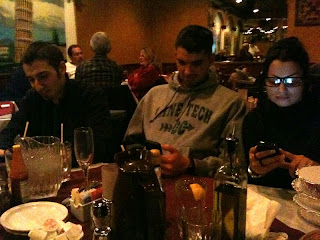Scintillating Dinner Conversations...

... on a tiny, tiny keyboard... that don't involve me. This is the frustrating reality of life in the smartphone era- a syndrome I refer to as Hyper-Connectivity Addiction. The syndrome presents itself as a constellation of symptoms, ranging from inappropriate use of electronic communication devices, prioritization of electronic interaction over personal interaction, and etiquette-busting rudeness with no sense of time or place for use of personal electronics. Over the last year, going out to dinner with others frequently turns from a time to share conversation and time together into a time where I watch someone play with a phone. Whether it is texting, talking, or checking their fairy-tale football team, the time at the table previously filled with witty banter, personal interaction and news exchange has transformed into the prime venue to catch up on trivial electronic business with the rest of the world. Now, it could just be that I'm boring and bring nothing to the...
